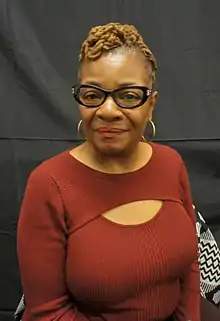Salimah Ali
Salimah Ali (born 1954) is an American contemporary photographer working in portraiture, documentary photography, and photo journalism.[1][2]
Salimah Ali | |
|---|---|
 Salimah Ali, 2010 | |
| Born | 1954 Harlem, New York City |
| Nationality | American |
| Occupation | Photographer |
Early life and education
Ali was born in 1954 in Harlem, New York City.[3] She spent her childhood in Manhattan, Brooklyn, and Queens.[4] Her interest in art was shaped from a young age by her father, an oil painter, who bought Ali her first camera.[5]
After beginning her photography career by shooting photos of babies and newlyweds, Ali got her first break while studying at LaGuardia Community College. She saw a poster advertising an Eddie Kendricks concert and contacted the show's promoter to ask if she could photograph the Kendricks. The promoter told her yes, and that opened the door for Ali to continue photographing other musicians,[5] including Stevie Wonder; Patti LaBelle; Earth, Wind, and Fire; Bob Marley; and others.[6]
Ali later transferred to the Fashion Institute of Technology, where she earned an associate's degree in photography.[4]
Career
Ali's work has appeared in a number of publications, including Essence, Black Enterprise, USA Today, The New York Times, Los Angeles Times, and The Washington Post.[7][8]
Ali is a member of Kamoinge, a New York–based collective of African American photographers. The group works to present honest portrayals of the African American experience through photography. In 2007, they got a grant to photograph the aftermath of Hurricane Katrina.[9] Ali participated in the project, taking photographs of New Orleans residents alongside the remains of their devastated homes.[10]
Since 2001, Ali has also worked professionally as a photographer for the New York City Police Department.[5]
Selected exhibitions
In 2018, an installation of Ali's photographs were shown at the Queens Library.[11] In 2019, Ali participated in a large group show at the African American Museum in Philadelphia.[12] In 2020, Ali showed in "Visions 1020," a photography exhibition at Wilmer Jennings Kenkeleba Gallery in the East Village, Manhattan.[13]
References
- "Salimah Ali". Photography Collections Preservation Project.
- "Salimah Ali – Artists at No Longer Empty". nolongerempty.
- "Salimah Ali: Legendary Eye • EBONY". EBONY. Retrieved April 8, 2022.
- "Member – Salimah Ali". Kamoinge. Retrieved July 12, 2020.
- "A Photojournalist On Both Sides Of The Law". The Culture Crush. Retrieved July 12, 2020.
- "Katrina: An Unnatural Disaster – Salimah Ali". www.katrinamedia.org.
- Finkelman, Paul (2009). Encyclopedia of African American History: 5-Volume Set. Oxford University Press, USA. ISBN 978-0-19-516779-5.
- ""Katrina: An Unnatural Disaster" at FotoWeek DC". www.opensocietyfoundations.org. Retrieved July 12, 2020.
- MacDonald, Kerri (May 3, 2011). "Intimate Moments in the African Diaspora". Lens Blog. Retrieved July 12, 2020.
- "Photographs by Salimah Ali". Katrina: An Unnatural Disaster. Retrieved July 27, 2020.
- "Why Southeast Queens Is Primed to Be NYC's Next Creative Hub". Observer. March 1, 2018. Retrieved July 12, 2020.
- "New AAMP exhibit examines Black masculinity with works by Black female and non-binary artists". The Philadelphia Citizen. October 1, 2019. Retrieved July 12, 2020.
- McCallister, Jared. "CARIBBEAT: Free 'History Month' session to help today's women attain sought-after mental, physical and financial health". nydailynews.com. Retrieved July 12, 2020.